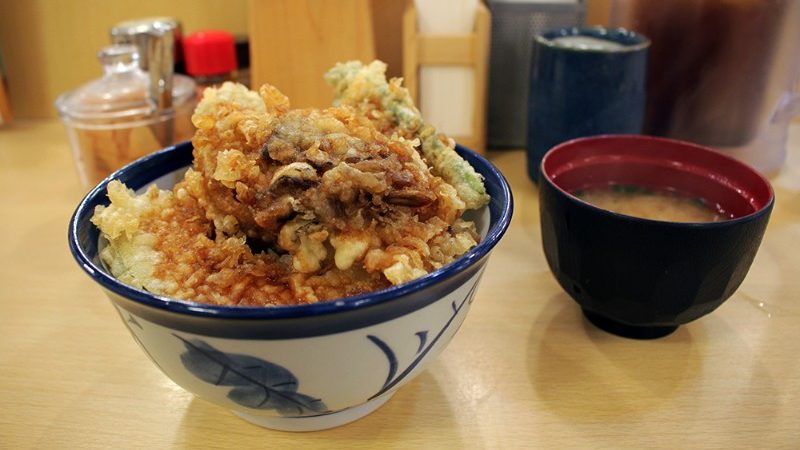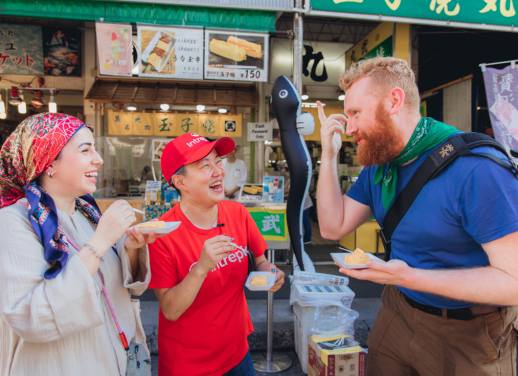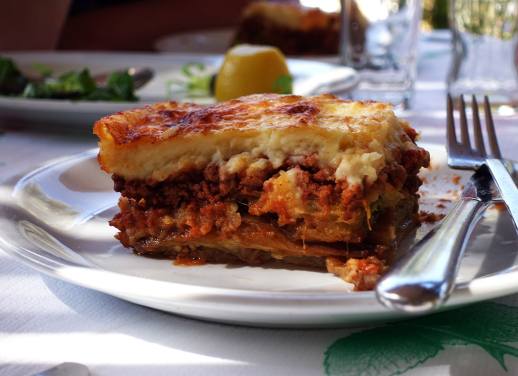Picture this: you’re vegetarian (or vegan) and you’ve just touched down in Tokyo, on your trip to Japan. You’re hungry and head to the nearest izakaya for a bite to eat.
You order an innocuous-sounding “daikon salad”, but it comes topped with a raw egg. You try a steamed spinach dish, but alas, it’s laced with several schools of dried mini-fish. A cabbage pancake appears shrouded in a thick fog of bonito flakes. The sauteed bean sprouts are sprinkled with a surprise addition of tiny pink prawns. So that’s it: you decide to stick with the cucumber makizushi rolls and the onigiri rice balls from Familymart.
But it doesn’t have to be this way for vegetarian and vegan travellers.
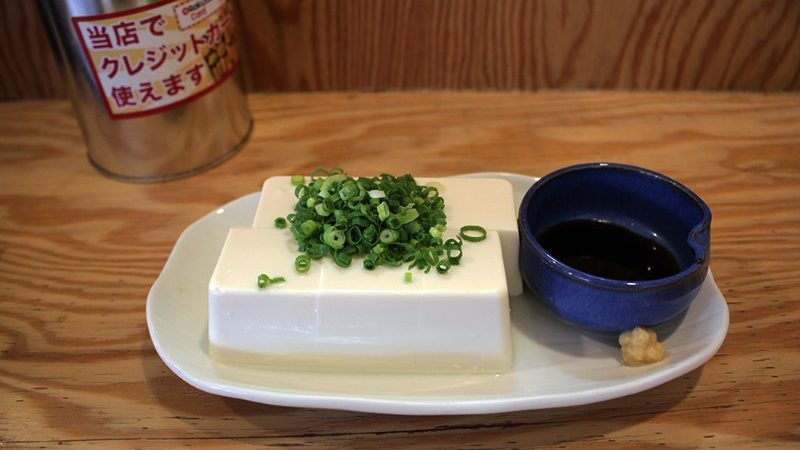
Chilled tofu with toppings.
And it doesn’t mean eating only at vegetarian and vegan restaurants in Japan either – you are just as entitled to a tendon (tempura-topped bowl of rice), things on sticks grilled over charcoal, and a steaming bowl of ramen as the omnivore next to you.
The hit-list of traditional foods that most people visit Japan with can be yours for the taking, just with a few precautionary measures.
EXPLORE JAPAN ON OUR 12-DAY CLASSIC JAPAN ADVENTURE
Potential offenders to look out for
Dashi. It’s the foundation of Japanese cuisine, and is found in everything from broths to dipping sauces, dressings, batters, omelettes, sauteed vegetables and beyond. The most common type of dashi uses bonito flakes (derived from tuna) and sometimes dried baby sardines. The vegetarian/vegan-friendly types, based on kombu seaweed or dried shiitake mushrooms, are less common but may be available on request or at vegetarian-friendly restaurants.
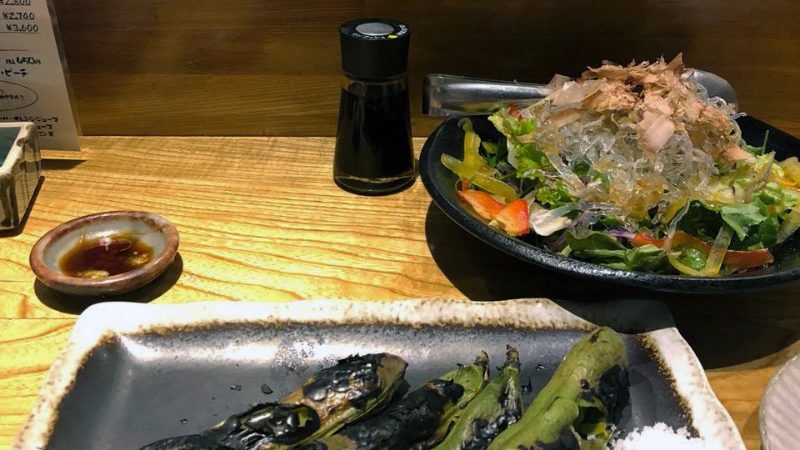
Bonito, a non-vegetarian-friendly condiment.
‘Sneaky’ ingredients, like eggs (often served raw or very lightly boiled/poached), mini fish (chiriko, chirimen, jako etc), katsuobushi/bonito flakes, and mentaiko (cod roe). These are often viewed as seasonings and therefore not in conflict with a non-meat/animal-product diet.
So how can you enjoy traditional Japanese cuisine, without compromising your ethics? With a little bit of forward planning, and this handy guide:
Sushi
This one is a little tricky considering the entire precept is fish. And to be fair, if you’re not eating meat, then chances are the idea of going to an establishment that is built on the concept of harvesting from the oceans, where you’ll be surrounded by the vision, smell and consumption of raw fish, chances are a sushi restaurant isn’t going to be high on your list. But if you do find yourself in or dragged to one, there are some options – how extensive they are will depend on the specific restaurant, so it’s best to check ahead.
What to watch: Fish and seafood (obviously), and fish and seafood-related products (fish eggs, fish sperm, crab brains etc); inari-zushi – the sweet pockets of tofu filled with rice, as the tofu is simmered in sweetened dashi; tamagoyaki, as it will most likely contain dashi.
Order: Eggplant (sometimes it comes pickled) nigiri, bamboo nigiri, ume (pickled plum) cucumber temaki, natto (fermented soy bean) rolls (if you’re brave), kappa maki (cucumber rolls), kanpyo maki (pickled daikon rolls), oshinko maki (Kyoto-style pickled vegetable rolls), okra nirigi, mushroom nigiri.
RELATED: HOW TO EAT AND DRINK LIKE A LOCAL IN JAPAN
Kushikatsu and Yakitori
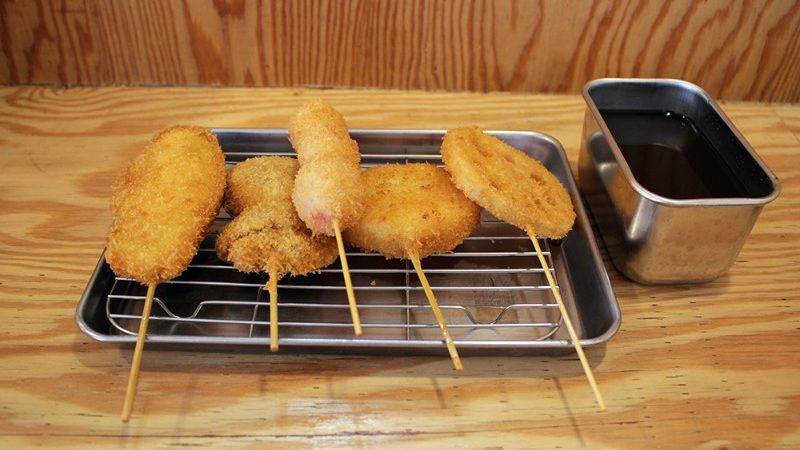
Kushi – crumbed veggies on skewers
In a nutshell, things on sticks. Kushikatsu are skewered ingredients that are crumbed and deep-fried, yakitori means “grilled chicken” but also encompasses other grilled things (ie. vegetables) on sticks. If, as a vegetarian/vegan, you can get past the plumes of grilling chicken flesh at a yakitori joint, and the fact your vegetables may be cooked alongside meat, you’ll find plenty on the menu to satiate you.
What to watch: The dipping sauce for kushikatsu; it’s a BBQ-type sauce that contains dashi.
Order: Eggplant, mushrooms (shiitake, erinigi), cherry tomatoes, mochi (rice cakes), ginnan, asparagus, leeks, onion, shishito peppers.
JOIN US ON A 12-DAY REAL FOOD ADVENTURE OF JAPAN (VEGETARIAN AND VEGAN FRIENDLY!)
Tempura
Tempura always comes with lots of vegetable options. In fact, traditionally, Kyoto tempura was only vegetables, due to its inland location. Depending on the season, you’ll find renkon (lotus), kabocha (pumpkin), satsumaimo (sweet potato), green beans, eggplant, mushrooms, sansai (wild mountain greens, a spring specialty), and much more.
What to watch: The dipping sauce, tsyuyu or mentsuyu (surprise, surprise, it contains dashi), but you can just opt for dipping the tempura in salt (traditional Kyoto style). Tokyo-style tempura sometimes contains egg in the batter: just check before booking or sitting down to eat.
Order: All of the vegetables. Ever.
Ramen
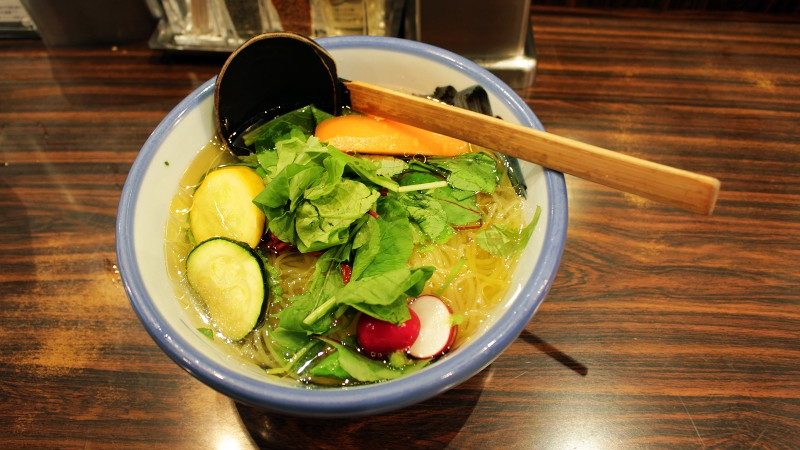
A warming bowl of vegan ramen.
A ramen lover knows that it’s all about the broth, whether their allegiance lies with a shio (salt), shoyu (soy-sauce), tonkotsu or miso base. But none of these are doable for the meat-adverse, as they contain dashi, and, in the case of tonkotsu, a pork bone broth. The good news is there’s (albeit small) a handful of ramen restaurants putting vegetarian and vegan-friendly items on the menu.
What to watch: All ramen not advertised as vegetarian or vegan. And even so, you may want to double-check the broth doesn’t contain katsuo-dashi.
Order: It depends on the establishment. Some have entire vegetarian/vegan menus, so you’ll have more options. Others will include a “veggie” or “vegan” ramen option. Afuri have a vegan-based broth topped with a rainbow of vegetables. T’s TanTan at Tokyo Station use a broth based on peanuts and sesame (white, gold or black). Soranoiro serve paprika-accented noodles in a carrot and cabbage-based broth, topped with seasonal vegetables. In Kyoto, tofu-professionals Mamezen have soy milk ramens that can be flavoured with interesting additions like hemp and charcoal, and feature mushrooms and other vegetables.
RELATED: EVERYTHING YOU NEED TO KNOW ABOUT ETIQUETTE IN JAPAN
Izakaya and Bar Snacks
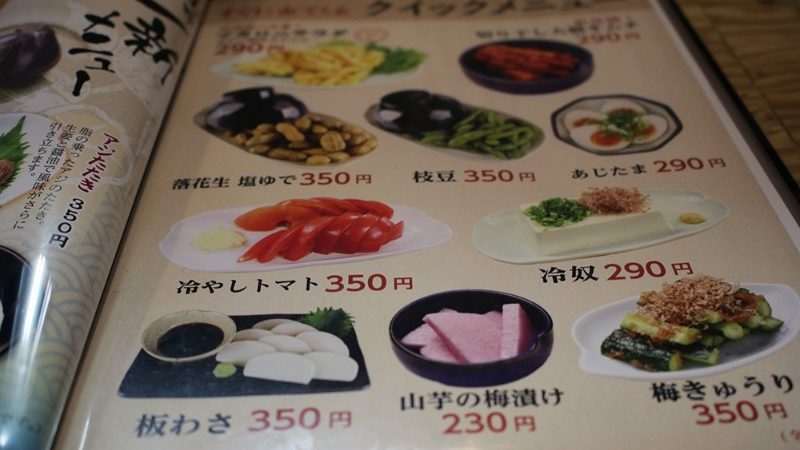
A vegetarian menu in an Izakaya.
Izakayas are most commonly described as Japanese “gastropubs”, probably because of the equal emphasis on booze and food. They’re generally a little rowdy, dimly lit, and offer an extensive menu covering appetisers, sashimi, salads, fried things, grilled things, stewed things, and deliciously curious Western-fusion things. In most of these categories, there’s something for the non meat-eater. Bars often serve a smaller version of an izakaya menu.
What to watch: Dashi-based sauces and dressings, mini fish and bonito flakes creeping into and on top of things – best to double-check with the wait staff on ordering.
CHECK OUT OUR RANGE OF SMALL GROUP ADVENTURES IN JAPAN NOW
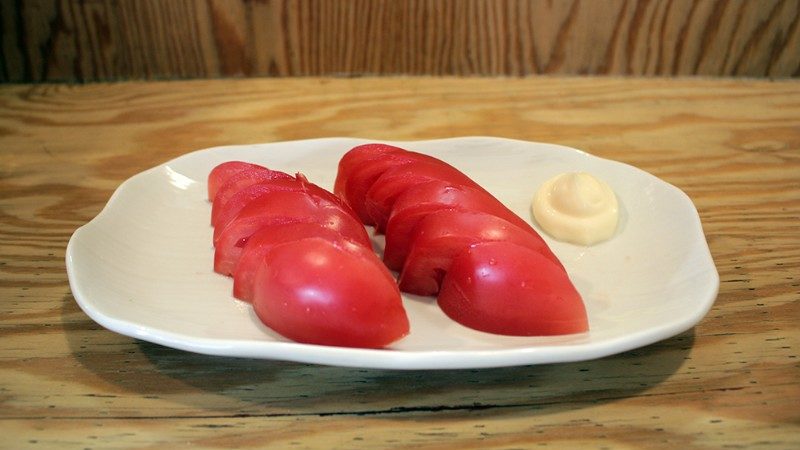
Tomatoes and kewpie mayo
Order: For appetisers, look for miso-cucumber (cucumber with miso paste) or umeboshi-cucumber (miso with umeboshi), gobo (burdock) chips, renkon (lotus root) chips, tsukemono (pickles), hiyashi tomato (cold tomato – sounds basic, but is delicious and fresh), hiyayakko (cold silken tofu topped with seasonings; just make sure to check what these are and ask any to be omitted, if necessary). There’s usually some kind of tempura and/or grilled seasonal vegetables on offer, like yaki-negi (grilled leeks) or yaki-nasu (grilled eggplant). They’ll always be a few types of salad, but just be sure to check the presence/absence of fish, meat or egg. Plus, of course, rice dishes a-plenty.
Soba/Udon
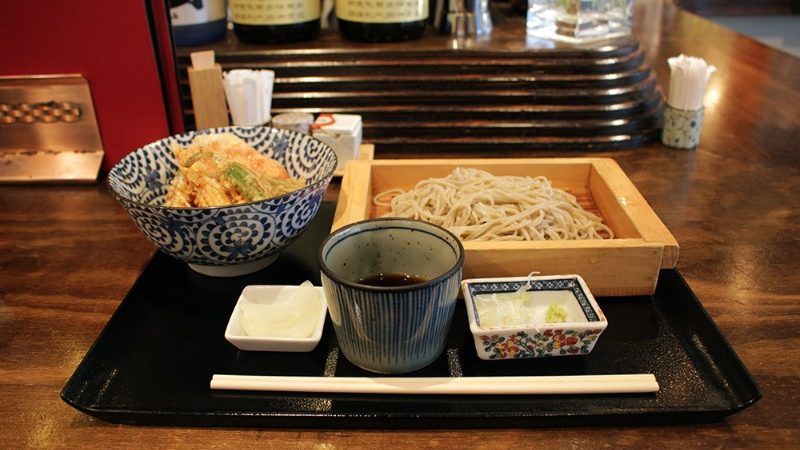
Soba noodles – delicious.
There’s two ways to eat these noodles: in a broth, or served on a bamboo basket with some condiments and a dipping sauce. The broth (unless you’re at a vegetarian restaurant) will be bashed on dashi, so your best bet is the basket, a style called zaru, seiro or tsumetai (cold). Local connoisseurs actually prefer eating them zaru-style, in order to appreciate the true flavours of the noodles. So you’ll impress locals as well as stick to your ethics.
What to watch: The dipping sauces. Tsuyu (or mentsuyu) is the dipping sauce that comes with zaru-style noodles. It contains dashi along with soy sauce and mirin, so you’ll want to leave it on the side. But go to town on the other condiments: sliced spring onion, freshly grated wasabi, sometimes myoga (native ginger) and a slice of sudachi or other Japanese citrus. Tables will also be equipped with different types of seasonings like shichimi togarashi, or ground black sesame seeds.
Order: Zaru/seiro/tsumetai (different places call it different things). Towards the end of a soba meal, you’ll be served the “soba-yu”: the water the noodles were cooked in. It’s served hot and you drink it like a tea. Usually you add it to the cup of dipping sauce, but you can just ask for a fresh cup (choko).
SUBSCRIBE TO INTREPID’S NEWSLETTER FOR TRAVEL TIPS, COMPETITIONS, GIVEAWAYS & MORE
Vegetarian and vegetable-heavy restaurants
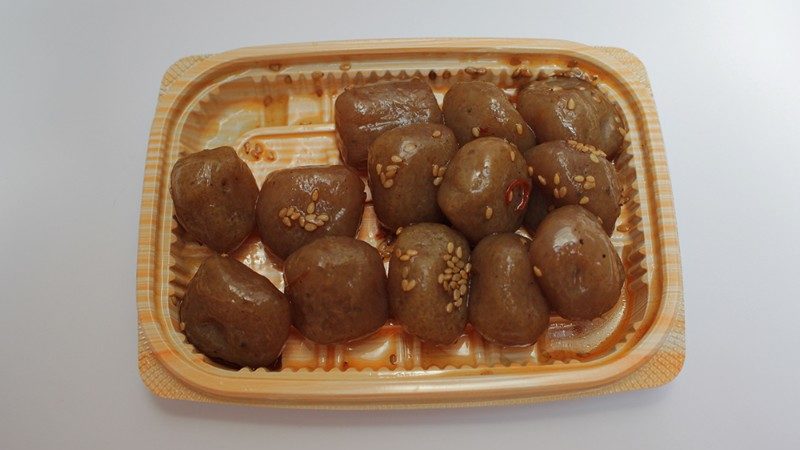
Konyakku!
Vegetarian and vegan restaurants are a safe-zone where you don’t have to worry about animal products surprising you in your meal, or asking for modifications. There has been a recent proliferation in such restaurants in Japan, particularly in the larger cities. Happy Cow is an indispensable resource for finding vegetarian and vegan restaurants.
In Kyoto, the prominence of Buddhist temples and the plant-based diet that goes with the religion, and Kyo-yasai (native local Kyoto vegetables) has sprouted a plethora of vegetarian and vegan restaurants. Little Heaven in Kyoto has vegetarian and vegan courses, including sushi. Biotei is a popular macrobiotic restaurant located in a cramped but comfortable room up a spiral staircase. Tousuiro serves tofu-focussed cuisine. For a fancier option, try Ukishima Garden for some Shojin Ryori.
In Tokyo, you can go for a colourful salads and vegan cakes at Eat More Greens, or for a more diverse menu try the organic selection at Tamana Shokudo in Aoyama. For an upmarket meal, try a vegetarian kaiseki (multi-course meal) at Bon, Daigo or Sougo.
Others things around town
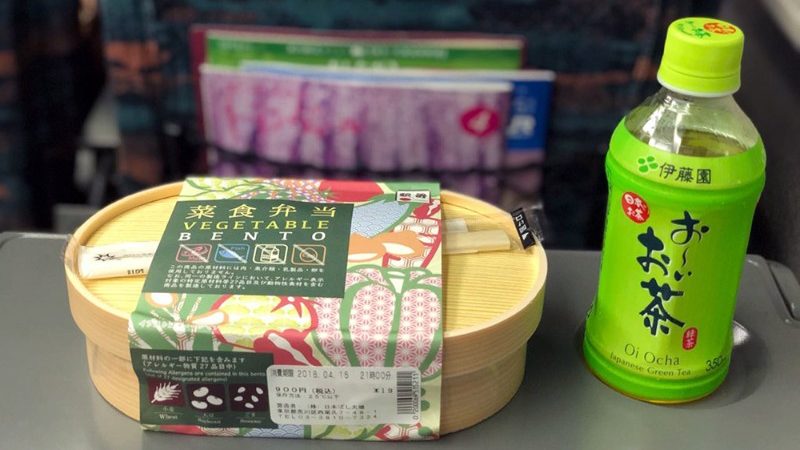
What‘s in the box?
Supermarkets and depachika (the basement food court wonderlands found in bigger department stores) have a slew of options for take-out meals. Sometimes salads that wouldn’t usually have meat products added do at the supermarket for boosting flavour and preservation sake; Google translate will become your best friend here. Organic stores can be found in Kyoto and in Tokyo will have more vegetarian and vegan options too.
RELATED: A LOCAL’S GUIDE TO VISITING JAPAN ON A BUDGET
Kaiseki requires booking ahead, and it’s at this point you can specify for a vegetarian or vegan version; ekiben (bento boxes available on Shinkansens) now have a vegan bento; bakeries will have lots of options, like red bean pretzels, edamame scrolls, black sesame and cheese bagels; wagashi are traditional Japanese sweets, which are all vegetarian and mostly vegan (apart from the more cake and pancake-like ones); robatayaki is a type of restaurant where ingredients are cooked over a charcoal grill or traditional Japanese heath; gyoza restaurants will most often have vegan options involving ingredients like tofu, cabbage, bean noodles, potato, soy beans, pumpkin and herbs; and good old onigiri (rice balls or triangles readily available from all convenience stores) with ume (pickled plum) or seaweed filling.
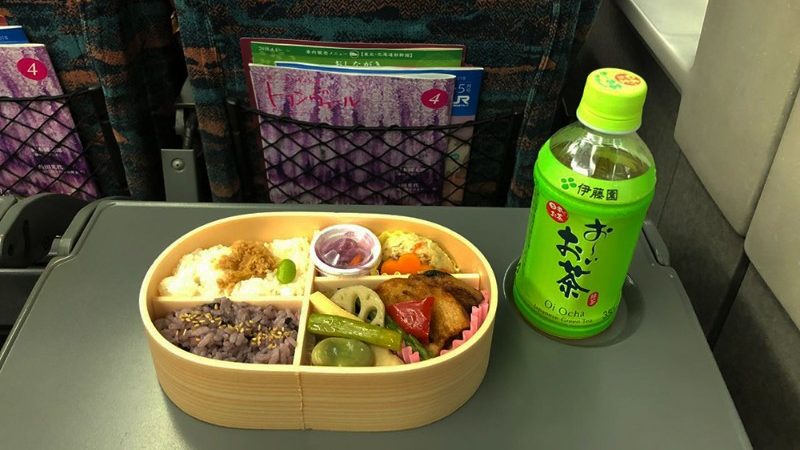
This! A yummy vegetable bento.
Some handy go-to phrases
Explaining your dietary situation: Watashi wa bejitarian/bigan desu – I am vegetarian/vegan
Key ingredients: Niku = meat; sakana = fish; shiifuudo = seafood; tamago = egg; cheezu = cheese; gyuunyu = milk; kuriimu = cream; katsuobushi = bonito flakes
Check if something contains animal products: _____ haiteimasueka? – Is there _____ in it?
Explain you don’t/can’t eat animal products: _____ tabemasen/taberaremasen – I don’t/can’t eat ____
Request the dish without the addition of a certain animal product: _____-nashi, kudasai (without _____, please) – niku-nashi (without meat), sakana-nashi (without fish)
Request the dish (eg. tempura) as vegetables only: Yasai dake, kudasai – vegetables only, please.
Basically, decide where you’re going to draw the line on dashi, arm yourself with some key phrases, do a bit of research, and come to Japan very, very hungry.
Explore Japan on a small group adventure with Intrepid now!

